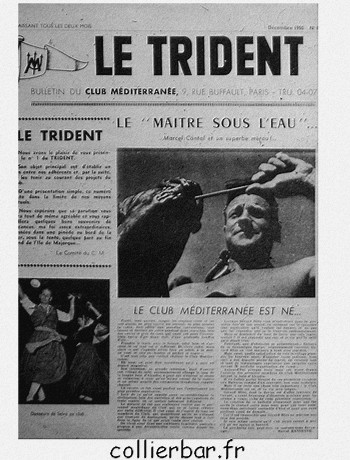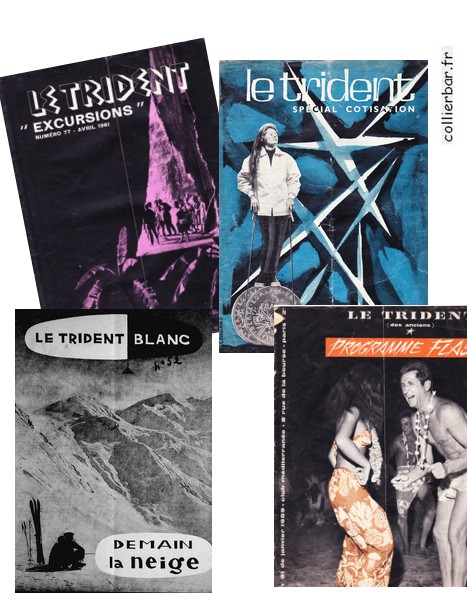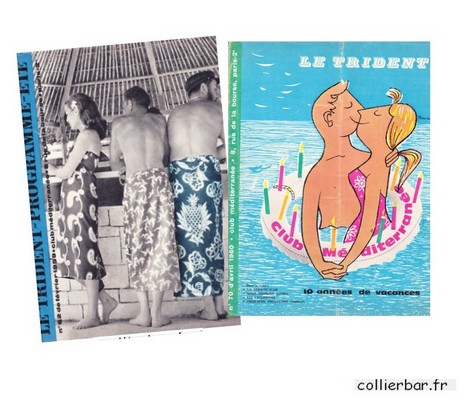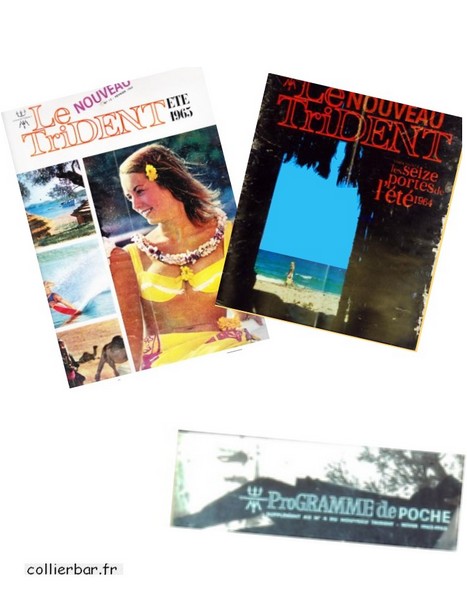At the end of the first season, it became necessary for the Club Méditerranée association to publish a small newsletter intended to inform members about the life of the association. The first issue was published in December 1950. Marcel Hansenne wrote the editorial.
From the small information sheet to today's large catalog
Composed of 4 to 8 pages depending on the issue, it is printed, 2 years after its first publication, in 30,000 copies. Its frequency is bimonthly (1 issue approximately every 2 months). Jean MAUBERT is responsible for the publication.
These first Tridents cover the club's various news, new villages, but also provide advice and other various recommendations for GMs. A "wedding and birth announcements" section is also included!!
The Trident also does not hesitate to self-criticize by indicating that such and such a thing is not going well within the club and that the managers (Gérard BLITZ first and foremost) will find a solution for the comfort of GMs.
There are also some advertisements, which were more like publicity at the time. Some of them even state that GMs are welcome at shop x or y and will sometimes be entitled to preferential rates.
In 1957, after the merger with the Magic Village club, Paul MORIHIEN took over the publication of the Trident. The Trident transformed and abandoned the newspaper format to become a small magazine with a cover that gradually took on color. The interior remained in black and white.
The talent of certain designers, GMs or GOs, would often illustrate these issues. Thus, we will find drawings by Maurice Sinet, better known under the pseudonym Bob SINE, Raymond PEYNET would also make his contribution, the little fish Anatole would see the light of day.
The small magazine has about twenty pages. It contains information on the organization of trips (self-criticism is always presented to the GM), the presentation of the villages with the indication of the village having obtained the Oscar of the year, special sections such as that of Jean Albert FOEX, or the texts of Jean de Baratti (Jean BALANDJIAN) as well as reports about major festive events such as the Club nights.
During this period, Club Méditerranée published several special issues throughout the year, such as the Trident des Anciens, the Trident special membership fee, the Trident special excursions, the 10th anniversary issue, the Trident Blanc, and the Trident Service Club.
In 1964, a revolution took place as the magazine changed format and was called, for a time, "Le Nouveau Trident". It still had the same theme but under a new formula with large photos and illustrations by André ESCARO. A pocket format as well as a guide in the "Michelin Green Guide" format indicating the sites to visit, the circuits to follow in the different countries of the Mediterranean will be published.
These experiments did not last and the Trident of the new era appeared in 1966. This Trident of the late sixties is almost the Trident that we know today, with a few minor differences.
From 1966, not only did the Trident modernize with fully color editions, but it also exported itself with the publication of foreign editions in the early 70s to better reach foreign GM (Germany, US version, Israeli, Japanese). Its publication frequency also changed. It would now only appear twice a year (Summer version, Winter version Snow/Sun). Its editorial line would not vary but its thickness would evolve according to the opening of new villages. As a preamble, the list of villages, a few pages on the club with the new features and then the villages listed and presented one by one with full-page texts and photos. The price list was included at the end before becoming independent at the end of the 90s.
The layout adopted landscape mode between 1973 and 1978. The return to portrait mode was later readapted.
The good old advertisement, visible during the 1950s, gave way to advertising for products stamped "Club Med boutique", and was demoted at the end of each issue.
Evolution of the price list:
Attached or detached from the Trident, the section devoted to holiday prices has also evolved. Here's a brief history.
In the first Tridents, prices for a stay lasting 3 weeks were indicated in old Francs (sic!). They appeared on the village page in a section titled "General Information" and accompanied by a box indicating the departure dates.
During the 1960s, they were grouped together on the last page of the Trident, on a special "General Information" page. Prices were indicated there in new Francs. It was not until the publication of modern editions in 1966 that a real price guide appeared. First inserted in the middle of the Trident, it was later placed at the end of the brochure.
At the end of the 1990s, the price list, which was converted into Euros in 2002, was the subject of a special guide separate from the Trident.
Today
Today, the Trident is available in several forms and nearly 25 different languages. In print, of course, but also, thanks to the rise of new digital media, in downloadable digital form.
Two things have not changed over time: the pleasure of leafing through it and the escape it provides to the reader.








